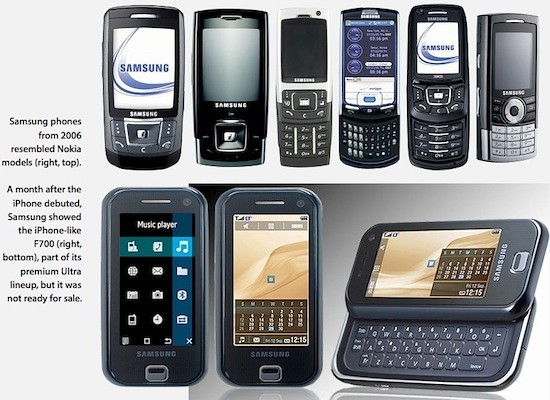Apple scored a notable legal victory earlier this week when they successfully convinced US District Judge Lucy Koh to not allow Samsung designer Hyong Shin Park from taking the stand and discussing the Samsung F700 phone, a device which Samsung claims pre-dates the iPhone and was inspired by a “bowl of water.”
Samsung had for some time been trying incorporate the F700 into its case because it was allegedly designed before the iPhone was announced and contains some of the more prominent iPhone design features. Note, though, that the F700 wasn’t released to the public until after the iPhone debuted.
In a court filing from last week, Samsung noted that Park was going to testify as to the design elements of the F700, including its “rectangular housing with four evenly-rounded corners, rounded edges on all four sides, a large, flat clear glass cover over the entire front face without ornamentation, a curved bezel that extends towards the back of the phone, an oblong speaker slot at the top of the front flat face, and a single optical jog button at the bottom of the front face.”
However, the Court had already ruled that the F700 was not admisseble as prior art. What’s more, Apple points out that Park herself has said that none of Samsung’s subsequent accused products were based on her work on the F700.
All that said, the following graphic from AppleInsider is rather telling.

Florian Mueller adds:
The F700 features some (though by far not all) of the visual characteristics of the iPhone and was launched shortly after Apple’s initial iPhone presentation in early 2007, but a Korean design patent related to it was filed the year before.
While Samsung is allowed to present the F700 only in connection with the question of whether certain iPhone design elements are functional (and therefore not protectable), Samsung’s lawyers have been looking for all sorts of ways to inject the F700 into the trial, preferably in contexts in which the jury may be (mis)led to consider the F700 a permissible prior art reference.
Judge Koh notes that “Ms. Park did not design any of the accused devices” and points to an inconsistency in Samsung’s position: “On the one hand, Samsung explains that Ms. Park will testify that the F700 was functional, but also that she obtained a [Korean] design patent […] for the same design”. Judge Koh furthermore remains concerned that using the F700 as an argument to counter Apple’s claims of willful infringement (by raising an independent creation defense) is too likely to lead to jury confusion, even if the court provided a limiting instruction.
via AppleInsider





Wed, Aug 15, 2012
News